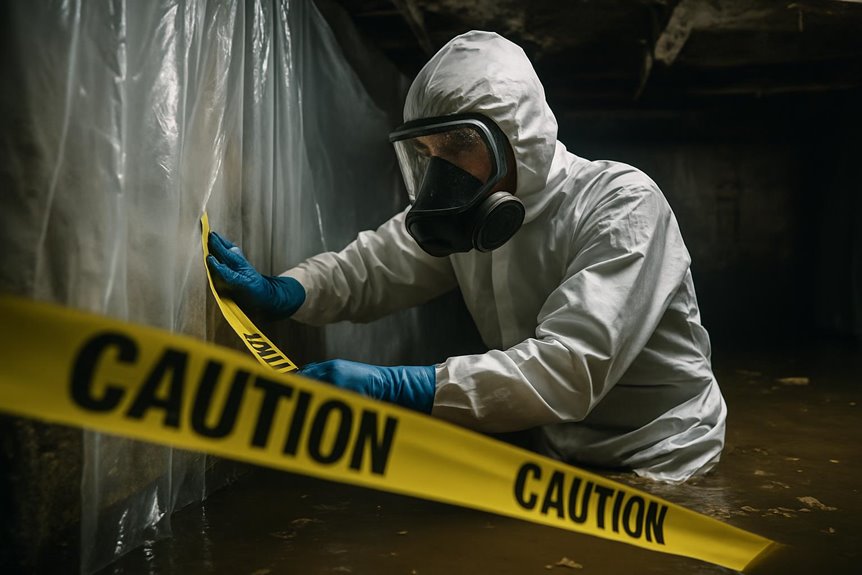Floods can expose hidden dangers, particularly asbestos. Safe removal is important to protect workers and the surrounding community. Identifying asbestos-containing materials before beginning cleanup is essential. Additionally, employing protective measures during the removal process helps minimize risks. Proper disposal is equally important to guarantee compliance with regulations. Understanding these recommended procedures is critical for effective and safe asbestos management in flood-affected areas. What are the specific steps involved in each of these practices?
Key Takeaways
- Conduct thorough asbestos risk assessments before starting removal to identify potential hazards in flood-affected materials.
- Utilize appropriate personal protective equipment (PPE) such as respirators and gloves to minimize exposure during removal.
- Implement wet removal techniques to suppress airborne asbestos fibers while handling contaminated materials.
- Ensure proper disposal of asbestos waste in compliance with local regulations to prevent exposure and environmental contamination.
- Maintain continuous air monitoring to ensure a safe environment for workers and occupants throughout the removal process.
Assessing Asbestos Risk Before Cleanup
Evaluating the risk of asbestos presence is an important first step before any cleanup efforts can commence. Proper risk evaluation involves a thorough understanding of the building materials and their potential asbestos content. Implementing effective testing procedures, such as air sampling and bulk material analysis, is vital to identify hazardous exposure levels. These assessments not only inform stakeholders about the safety of the environment but also guide the appropriate response strategies. Additionally, following established asbestos abatement practices can significantly reduce the risk of exposure during cleanup activities. It is crucial to understand that asbestos removal must be conducted by trained professionals to ensure safety and compliance with regulations.
Implementing Protective Measures During Removal
When asbestos removal is undertaken, implementing protective measures is essential to secure the safety of workers and occupants. This involves utilizing appropriate protective gear and employing effective removal techniques to minimize exposure to hazardous materials. Key measures include the use of respirators, disposable coveralls, and gloves, assuring that all personnel are adequately trained in safe practices.
| Protective Gear |
Removal Techniques |
Additional Safety Measures |
| Respirators |
Wet removal |
Air monitoring |
| Disposable coveralls |
Encapsulation |
Decontamination stations |
| Gloves |
Negative pressure enclosures |
Signage and barriers |
| Safety goggles |
HEPA vacuum |
Training and drills |
| Hard hats |
Manual removal |
Emergency response plans |
These precautions help secure a safer environment during the asbestos removal process.
Ensuring Proper Disposal and Compliance
Guaranteeing proper disposal and compliance with regulations is critical to the safe management of asbestos removal projects. Adhering to disposal regulations is essential to protect public health and the environment during and after floods.
Waste management procedures must include the secure containment of asbestos materials, using approved containers, and labeling them clearly to prevent accidental exposure. It is important for contractors to familiarize themselves with local, state, and federal guidelines to avoid penalties and guarantee safe handling of hazardous waste.
Additionally, proper documentation of disposal activities is necessary to maintain transparency and accountability. By following these recommended approaches, individuals and organizations can promote safety and contribute to effective asbestos management, allowing for greater freedom and peace of mind in affected communities.
Frequently Asked Questions
How Can I Identify Asbestos-Containing Materials in My Home?
To identify asbestos-containing materials, homeowners should consider professional asbestos testing services. Material identification can be conducted through visual inspection, focusing on common areas such as insulation, flooring, and roofing, ensuring a thorough assessment of potential hazards.
What Personal Protective Equipment Is Recommended for Asbestos Removal?
When removing asbestos, it is essential to wear proper personal protective equipment. Recommended items include asbestos suits for full-body protection and respiratory protection, such as masks or respirators, to safeguard against inhalation of harmful fibers.
Can I Remove Asbestos Myself During a Flood?
Removing asbestos oneself during a flood poses significant risks. Asbestos safety protocols are critical, and DIY removal often lacks the necessary expertise and protective measures, potentially endangering health. Professional assistance is strongly recommended to guarantee safety.
What Should I Do if I Accidentally Disturb Asbestos?
If asbestos is accidentally disturbed, the individual should initiate emergency response procedures immediately, prioritizing safety. They must avoid further exposure, evacuate the area, and contact professionals to assess health risks and manage the situation effectively.
Are There Specific Regulations for Asbestos Removal After Flooding?
Asbestos regulations vary by region, especially after flooding. Compliance with flood safety guidelines is essential, ensuring proper assessment and removal procedures to protect public health and the environment while maintaining individual freedom in decision-making.
Conclusion
To sum up, safe asbestos removal during floods is vital for protecting public health and worker safety. By conducting thorough risk assessments, implementing effective protective measures, and ensuring compliant disposal methods, the risks associated with asbestos exposure can be greatly reduced. Adhering to these recommended practices not only safeguards individuals but also promotes a more efficient and responsible cleanup process. Ultimately, prioritizing safety and compliance in asbestos removal is essential in the aftermath of flooding events.

